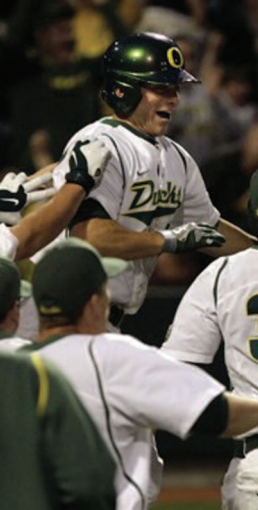
College baseball's best teams set out every year with one goal in mind: the College World Series. Known by many as simply 'Omaha,' the CWS is a place where all styles of baseball have met – in the past, present, and foreseeable future.
Many teams check in at Omaha thanks to solid pitching, great defense, and timely hitting. With recent adjustments to the college game, however, more and more programs have implemented bunting, hit-and-run, small ball or 'west coast' techniques in their programs.
Of course, there was a time that 'west coast baseball' stayed, well, on the west coast. "It all started with Wally Kincaid," said University of Oregon head coach George Horton, who made nine trips to the College World Series (six as head coach, three as an assistant) with Cal-State Fullerton. "He was light years ahead of the details of the game and the style of baseball when he was coaching me."
Kincaid coached at California's Cerritos College for 22 years, posting a career record of 678-163 that included an incredible 60-game winning streak. A recipient of the 2008 ABCA Hall of Fame/Coach of the Year and an inductee into the 2010 College Baseball Hall of Fame, Kincaid also has the field at Cerritos College named in his honor.
"Now that it's evolved," Horton said of west coast baseball, "it's been passed along to guys like Augie Garrido, Don Sneddon, Dave Snow, Mike Weathers, Mike Gillespie, myself and many others. At the end of the day, it's more of a cerebral, cat-and-mouse approach, where the bunting game, picking pitches, and little details with offensive execution are emphasized. It isn't that we think we invented the game or that it's a better game or whatever, but it's a different style of game, just like west coast football."
Gary Henderson, head coach at the University of Kentucky, has also seen the college game change in recent years. In his tenure, Henderson has made coaching stops at San Diego State, Cal-State Fullerton, Pepperdine, Florida and Oregon State, among others. "I think the term 'west coast baseball' has changed over time," he said. "The connotation used to be more short game, more small ball, more base running, more of a pressure offense and less of a 'three-run homer' approach, but that's changing."
Naturally, the 'west coast' tag is no longer solely applicable to baseball in California and surrounding areas. Take University of Tennessee head coach Dave Serrano, who also has coaching experience at Cal State Fullerton, UC Irvine and Cerritos College . "I'm not offended by it, but I just don't know why people are categorized as 'west coast' or 'east coast' guys; they're baseball coaches," he said. "I think there are philosophies that are the same and those that are different on both sides of the country."
While geographical implications seem to be less and less relevant with the style of play in college baseball, there are differences from east to west that appear to be constant.
"Recruiting is much easier on the west coast," Serrano offers, "you can roll out of your bed and see some of the top players in the country that are a baseball's throw from your house. You can go down to Ryan Lemmon Stadium or Blair Field four days a week and watch a handful of guys that are Division-I ready and able to be recruited. On the east coast, you have to get in your car more, you have to get on a plane more, so you have to be more exact on who you're going to go see."
"One of the biggest differences is how far you have to go to get recruits," agreed Henderson. "In highly populated areas- southern California, northern California, Phoenix, Dallas, Houston, Tampa St. Pete, Orlando- a lot of it is done in the car," said Henderson, who led his Wildcats to a no. 1 national ranking during the regular season. "When you're in the Midwest or the Northwest, a lot of it is done by getting on an airplane."
"They (Serrano and Henderson) are right," Horton acknowledges, "the concentrations of quality players, programs, club teams, et cetera is higher in some areas. You have to pick and choose your spots, and just like in the east and most other states, you have to be more organized; even where I'm at, you can't just get in the car and drive 30 minutes and see a bunch of third basemen or shortstops or whatever."
From east to west, many college programs seem to be fighting the same battles, both on the recruiting trail and the playing field. When teams talk about reaching Omaha nowadays, it's more about the game's best merging together to determine a champion. With the attendance and popularity of the College World Series reaching all-time highs in recent years, perhaps the competition on the road to Omaha is as well.